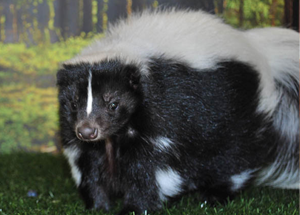
- VisitSupport Happy HollowDONATE TODAYExploreSupport Happy HollowDONATE TODAYLearnSupport Happy HollowDONATE TODAYSupport
-
Today's Hours: 10:00 am to 5:00 pm
Education AmbassadorsStriped skunk

Scientific name: Mephitis mephitis
Family: Mephitidae
Order: Carnivora
Class: Mammalia
Range: North America
Habitat: Grassland, Temperate Forest, Urban, Woodland
Lifespan: three to five years in the wild, up to 15 in captivityWhat do they look like?
Striped skunks are characteristically known for their black fur with a white stripe that starts at the top of the head, and then splits around the nape into two stripes that travel down the sides of the back and merge again near the base of their bushy tails. On average they weigh six to eight pounds, but have been known to get as large as 14 pounds. Their average length is 21 to 28 inches, with males typically larger than females. They have a small head with small eyes and a pointed snout. Their feet have partially webbed toes and long claws for digging.How do they behave?
Striped skunks are mostly nocturnal (active at night), but can be crepuscular (active during dawn and dusk) as well. They live in dens or burrows underground. They do not hibernate, but will go into a state of torpor (slowed activity) during the winter. Skunks don’t have very good eyesight, but have excellent hearing and sense of smell. Skunks are known for their spraying defense. When threatened, a skunk will raise its tail and stomp its feet as a warning. They will also hiss and growl, with the last resort being to spray, which can travel 10 to 15 feet with a high degree of accuracy. The smell aside, the spray can cause irritation and even temporary blindness and is sufficiently powerful to be detected by a human nose up to a mile away. Skunks can be a bit reluctant to spray as their scent glands can only hold enough fluid for five to six sprays. Once all the fluid has been used, it takes the scent glands up to 10 days to produce a new supply.What do they eat?
Striped skunks are omnivores (they eat both meat and plants) as well as opportunistic eaters. They will eat anything from insects, plants, nuts, and fruit to small mammals, fish, birds, amphibians, and eggs. They will even eat carrion (dead animals). Skunks will also eat honey where they can find it; their thick fur protects them from the stings of honeybees guarding their hive. At Happy Hollow, they eat fruit, vegetables, insects, eggs and insectivore pellets.How are they born?
Skunks breed once a year between February and March. After a gestation of about 60 to 70 days, a female will give birth to a litter of usually 5-6 young. Babies are born blind, deaf and hairless. They are weaned between six to eight weeks of age and begin venturing out with their mother. Sometimes they will continue to live in a family group for up to a year before the young skunks go out on their own.Conservation
The striped skunk’s conservation status is currently listed as Least Concern by the International Union for Conservation of Nature . Although striped skunk populations are stable, these skunks are still impacted by human influences such as the use of rodenticides (chemicals used to poison rodents). Skunks are known carrion eaters; they will often consume rodents that have been poisoned with rodenticides, resulting in their own death. To help ensure that the skunks continue to live in a healthy ecosystem, you can avoid using rat poison. This action will not only keep prey animals safe for skunks to eat, but will also make your yard safer for children and pets.
Zoo on the Hill
Located across from the Keep-Around Carousel is the Zoo on the Hill. Learn about wildlife up close during daily meet-and-greets, leap like a lemur on the playground, brush and feed the goats,, or take a peek inside Doc’s Critter Care building and the Ranch House. Double-H Ranch features a combination of animal exhibits, including giant anteaters and red ruffed lemurs, as well chickens and domesticated animals that are docile enough to touch.

Zoo in the Hollow
Follow the crooked bamboo pathway down into the hollow and visit with some of the most amazing animals in the world. Where else in San José can you get up close to a stunning jaguar, lemur, meerkat or American alligator? Happy Hollow is dedicated to helping save species and preserve wildlife for future generations by participating in Species Survival Plan programs through the Association of Zoos and Aquariums.